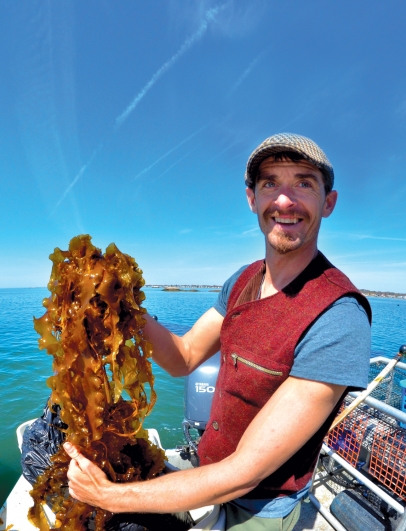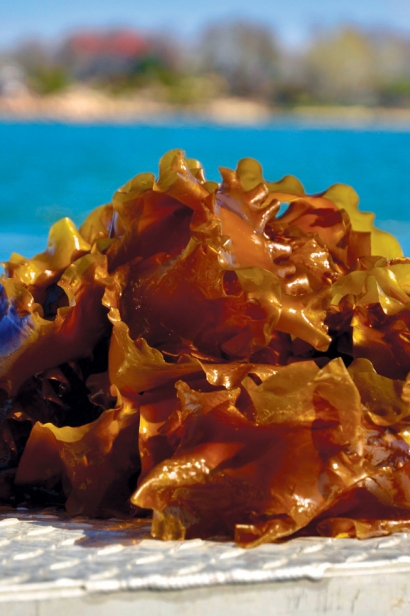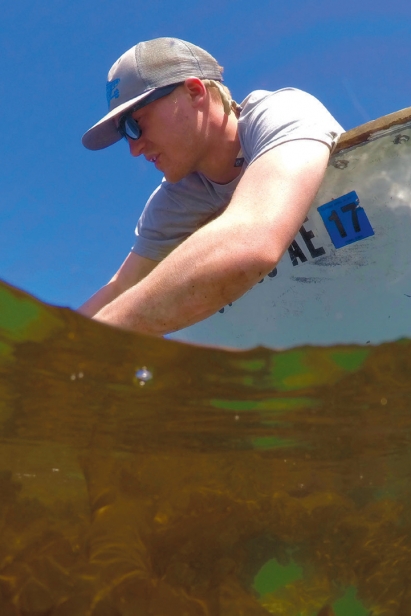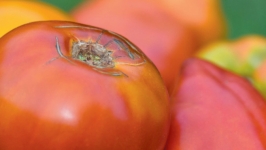Kelp: The Gateway Vegetable
GreenWave's Ocean Farming Initiative
It's difficult to see Thimble Island Farm. There are no perimeter fences, tractors, or tilling tools. The farm produces seven crops and yields dozens of tons annually on only three acres. But you might be right above it and have no idea what's growing below, because it's all under water.
The farm is Bren Smith's, and he says that's the point. "Anybody can boat or swim here. We own a process, not the property rights," he says, tugging at the brim of his worn Hartford Whalers cap. Located among the Thimble Islands in Long Island Sound, his 3-D vertical ocean farm is invisible above the water, save buoys attached to kelp lines. Those lines support ten tons of kelp per acre, as well as clams, oysters, mussels, scallops, and whelk, all of which are making their way to the local dining scene.
Smith wasn't always a farmer. He dropped out of school at 14, and after a stint as a night-shift hospital janitor, he turned to commercial fishing. In some ways, Smith is still a typical fisherman. He can't swim, and his life story seems to vary whenever he tells it. "Up north, we really don't swim," he says. "If you go over in the Grand Banks, you're not coming back. Swimming just prolongs the drowning."
After more than a decade hauling and trawling for lobster, cod, and crab, Smith recognized the need for sustainable ocean production. Although he was born "on the edge of the earth" in Canada, his parents were from Connecticut and New York, and it was to Connecticut that Smith returned to farm shellfish. He set up a CSF, or community-supported fishery, which is similar to a CSA in that individuals absorb some of the risk as well as reap the benefits of an investment in local food production.
"I wooed my wife with CSF shares," Smith says of his wife, Tamanna Rahman, whom he credits with many of their most popular kelp dishes. Rahman was a nursing student at Yale when Smith dropped off a share of oysters and clams. She didn't know she was allergic. "She had a reaction that night. She swelled up, and her throat closed." The next day, Smith got a message from Rahman that said, "You poisoned me!" and they've been together since. "Clearly, there are many ways to a woman's heart," Smith says.
Then came Hurricanes Irene and Sandy, which decimated the shellfish beds. Not one to be deterred, Smith connected with Dr. Charles Yarish, a USDA/NIFA-funded expert on cultivation technologies of economically and ecologically important marine plants at UCONN's Stamford branch, to incorporate kelp into his farming model. Kelp, Yarish says, mitigates the effects of surge while adding a whole new crop. Smith says it's the farm of the future. "It's zero-input. No land, no fresh water, no added fertilizers. And there are thousands of sea vegetables we could be eating. Kelp is just the gateway vegetable."
Sugar kelp grows 8-12 feet over the winter and is rich in vitamins A, B, C, and E, iodine, magnesium, and potassium. Its rapid growth limits farmers' risk, as does its versatility. No matter the water quality, kelp remains a viable product. Smith partners with scientists to ensure purity, but kelp is also used in fertilizers, and kelp that has absorbed heavy metals can be turned into biofuel.
And the taste? The Sound is ideal for kelp cultivation, producing a fine merroir. Familiar to oyster connoisseurs, the term reflects the particular flavors of a location, similar to the way that vintners use terroir to describe grapes. The translucent leaves harvested from the Thimble Islands have a mild sweet-salty taste, particularly after blanching, that pairs well with other flavors.
Jeffry Trombetta is a professor of hospitality and culinary arts at Norwalk Community College, which trains many chefs who go on to work in area country clubs. He teaches courses in sea vegetable recipe development and sources most of his kelp from Smith. "As a chef, I appreciate that kelp is difficult to overcook," he says. "I can wrap a piece of monkfish tail and pan sauté it. It can sit in hot oil without wilting, then finish off in the oven." It also brings out other flavors. "Kelp has natural glutamate factor," he says, "which means it enhances and marries well with other things." His favorite pairing? Kelp and corn. But, lately, kelp alone has been his "go-to herb," and he says home chefs can feel comfortable reaching for it, like they'd reach for the basil.
Chef Jeff Laboda at New Haven's Caseus likes to pan fry the leaves and toss them on unexpected dishes for a burst of nutrition and flavor. He also serves pickled kelp stem, kelp butter, and kelp pesto, all sourced from Smith's farm. The spring menu features chickpea flour panisse and pan-fried kelp with a kelp aoli for dipping. Owner Jason Sobocinski says Caseus "is on the kelp train."
A little farther afield, Brooks Headley, former pastry chef at Del Posto, is making a splash with Smith's kelp at his Superiority Burger in Manhattan, serving BBQ kelp noodles paired with parsnips.
But as Smith will be the first to tell you, "This isn't the story of an elite food. It's the fish stick of the future." Companies like Google and Purina, as well as schools and hospitals, are also lining up to board the kelp train. "We've had this real blind spot about ocean vegetables, but that's kind of what's exciting about it." Chef Laboda agrees. "It's like there's suddenly a whole new world to work with," he says.
To help bring kelp into the mainstream, Smith formed GreenWave, a nonprofit to support vertical ocean farmers. Farmers supply their own boat, lines, anchors, and buoys and lease an acre of ocean from their state or municipality. GreenWave provides low-cost seed, training, gear, and a guarantee to purchase 80% of the crop for five years at three times market rate. There are currently eight individually managed farms in various stages of development around New York and New England, and GreenWave's ideal is 25. The goal is to create a culture of sharing, investigation, and creativity around kelp. Fellowships are also awarded to those who want to engineer farms, research kelp, make kelp art, or do almost anything else to contribute to the common vision. Nothing can be proprietary. Everything is open source.
This summer, GreenWave plans to launch the world's first underwater community garden. People pay a membership fee then gather twice a month to tend their own segment of kelp, oysters, and mussels. "We're talking about a big harvest party on a barge with Caseus." Smith says. They'll prepare a variety of dishes, and the farmers will learn new ways of eating while reaping the benefits of their harvest.
But Smith doesn't plan to stop there. Through GreenWave, he envisions a seafood hub in the New Haven area, consisting of sea vegetable seed banks, a CSF, food trucks, a kelp moonshine called SeaShine, a processing plant featuring a Korean squid slicer that's been modified to cut kelp noodles, and maybe even farmed barrimundi (one of the most sustainable farmed fishes with the smallest impact). Eventually, they'll incorporate other sea vegetables like sea lettuce, Irish moss, dulse (the bacon seaweed), grassilaria, and other kelp varieties. "We'll have a lot of ideas that will fail in the hub," he says, "and that's good, because out of those failures, things will come together."
For Smith, a big part of the excitement is about returning to our Connecticut roots in a way that provides local, farm-fresh produce and is beneficial to the environment. "You want an image of how much our oceans have changed, it's the whale in Connecticut," Smith says. "It's our state animal, and we even lost the Whalers. We have this history of seafood, of fishing, of shellfishing, and this deep connection to the Sound. It's been core to our identity for generations, and it just so happens that this is ground zero for ocean greens. That's really exciting for people who love food, who love to cook, who want to revive our fishing industry, and who care about restoring our oceans."
GreenWave: New Haven









